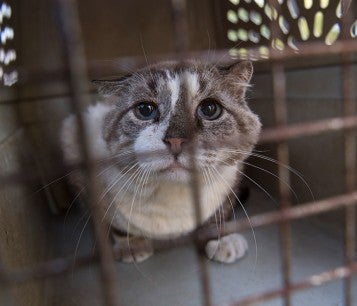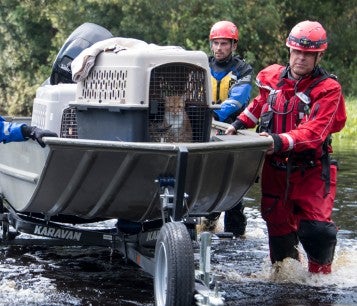Although community cats are resourceful and instinctively seek out safe places in times of danger, extreme weather may pose a threat to them. If you take care of a colony of cats, there are many things you can do to increase their chances of coming through the storm safe and sound.
What to do right now
-
Create (and update) a list—complete with detailed descriptions and photos—of all the cats in the colony you care for. After a storm, this list may help you locate displaced cats and recover those being cared for by shelters or other rescue groups.
-
Gather veterinary records for the cats (including microchip numbers if the cats are chipped) and store them in a safe place.
-
Make sure you have cell phone numbers for other neighbors who may also feed the cats so you can connect with them to locate lost cats or make sure those remaining are cared for.
-
Find someone who will commit to being a back-up caretaker in your absence.
-
Carry the contact information for your secondary caretaker in your wallet. Also post the information on your refrigerator or some other visible place in your home.
-
Collect contact information for local shelters and rescue groups. They may be able to help you locate cats who have gone missing.
-
For extra security, save digital copies of all gathered information.
What to do when bad weather threatens community cats
Consider what type of natural disaster you are dealing with and what kind of havoc it will wreak on your neighborhood. Will there be high winds, flooding or fire?
-
Post laminated signs on or near cat shelters and feeding stations alerting any emergency responders that this is a managed group of cats and include contact information.
-
Secure or remove objects (such as chairs, potted plants or garden utensils) in and near the colony that could become airborne during high winds or get washed away.
-
Move shelters and feeding stations to higher ground in areas that may flood. Raise shelters and feeding stations to keep them dry. You'll find wooden shipping pallets, available at some lumber yards, are ideal for this purpose.
-
Tie shelters and feeders to permanent structures (like a fence or a sturdy tree) to anchor them or wedge them tightly into a secure space. Be careful about placing heavy objects (e.g., bricks, boards or rocks) on top of shelters to keep them in place, as these may pose a danger in high winds.
-
Keep rain out by positioning shelters so their openings face a wall or so that the entrances of two shelters face each other, no more than a foot apart.
-
Cover shelters and feeding stations with heavy tarps to keep out driving rain. Tie tarps at an angle and extend any overhang over shelter doors so water can run off and away from shelter doors. Hammer stakes securely and/or tie the tarps to a permanent structure.
-
Leave extra dry food in covered feeding stations in case you can't return soon and place extra kibble inside the cats' shelter, as far from the openings as possible. Don't put water in the shelter—it's important that the shelter and cats remain warm and dry.
-
Leave out several bowls of water, particularly if your concern is fire rather than a storm.
-
Lay Mylar blankets inside the shelters for extra warmth.
-
Put portable shelters, litter boxes, food and water in an accessible shed or garage during the storm.
-
Stockpile adequate cat food, bottled water, extra batteries and flashlights and store them in a place that will be safe from the disaster.
-
If possible, trap the friendly cats and kittens young enough to be socialized prior to the storm and take them to a safe place. Don’t fret over leaving the unsocial and feral ones, as they have excellent survival instincts.
We never know where disasters will strike or when animals may be in need of urgent rescue, but we know we must be ready. Your support makes this lifesaving work possible.

What to do when it's safe to return to the community cat colony
Once you are allowed to return home, restore a normal environment and feeding routine as soon as possible in order to help draw the cats back. Take note of the cats, who is there and who is missing. Search nearby and contact other caretakers to compare notes. Check the cats for any injuries or signs of illness.
If you are unable to return to the cats’ home, contact the local police precinct to learn what options are available to provide care for the cats, such as gaining temporary access or coordinating with emergency responders.
How to restore order to the cats' home
- Be cautious of branches and other debris that may continue to fall after the storm has ended.
- Remove broken lumber and glass, nails or other sharp objects to prevent injury and infection.
- Repair damaged feeding stations and shelters. Rebuild shelters, if necessary. Clean out and replace wet insulation materials (straw, newspaper or linens).
- Disinfect shelters, feeding stations and dishes if they were exposed to flood waters. Use a nontoxic, cat-safe disinfectant. (Check with your veterinarian or animal shelter to see what products are safe.)
- Put out more fresh water than usual because standing water is probably contaminated.
Learn more about our animal rescue efforts that take place during hurricanes, tornadoes, wildfires and more.

How to find missing community cats
-
Don't panic if you can't find all the cats at once. They're probably close, but too frightened to return to their home. Most cats will return within a week, but some may take a few weeks to come back.
-
Search high and low: The cats may have climbed high to escape flood waters or may be hiding in or under a building that’s not suffered too much damage from the disaster.
-
Offer tempting foods such as canned tuna, rotisserie chicken or their favorite treat to coax frightened cats into returning.
-
Since the cats may be slow to show themselves, consider placing motion activated cameras to monitor the area while you are not around.
-
Contact the local animal control agency, shelter and any rescue groups in the vicinity. Find out which organization, if any, has rescued cats from the affected area and where to go to identify any cat that may be yours.
What to do once you've found the cats
-
Check the cats for injuries or illness as thoroughly as you can. (You may only be able to examine the community cats by watching them.)
-
Consult your veterinarian on how best to treat the cats and determine if they need to be trapped and transported to a clinic. The disaster may have also impacted veterinarians’ capacity to provide services, so make sure any sick or injured outdoor cat can be seen by a veterinarian before trapping.
-
Trap injured or sick cats as soon as possible and get them medical care.
Find Affordable Veterinary Care
Additional resources
- Pet disaster preparedness: Prevent tragedy by preparing for a disaster or everyday emergency before it happens
- Equine disaster preparedness: Horses require extra consideration in disaster planning
- Livestock disaster preparedness: Be prepared in the event of an emergency
- Wildlife disaster preparedness: You can give wild animals a helping hand during extreme weather
- Outdoor cats FAQ: Outdoor cats, often called feral cats or community cats, are domestic cats who live outdoors and without a clear owner.
